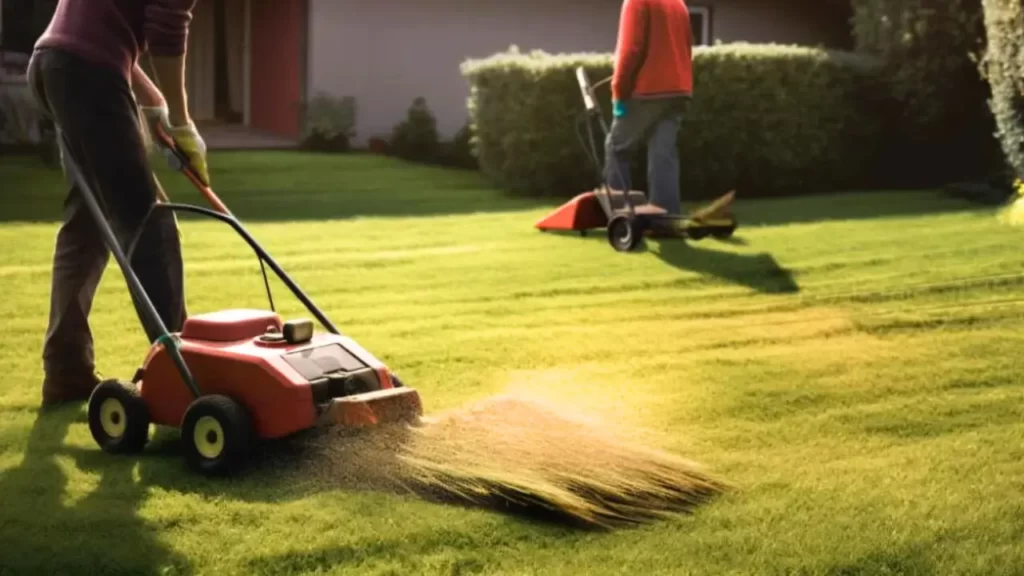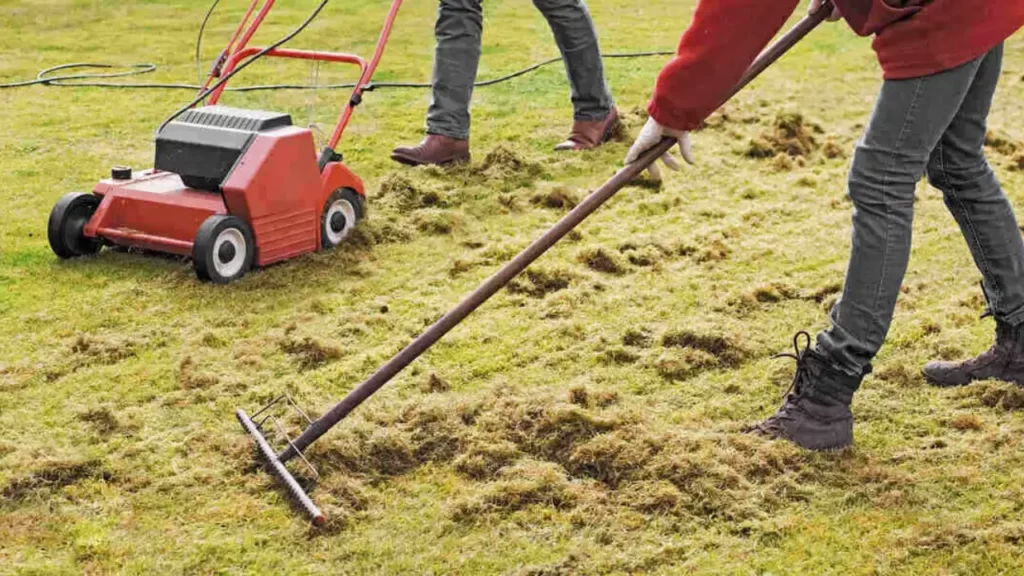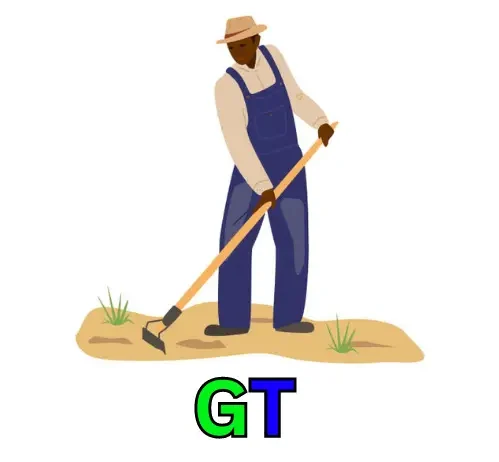Maintaining a healthy and lush lawn is the top priority of most homeowners. And most homeowners choose Bermuda grass for their lawns due to its ability to withstand multiple climates. But over time thatch can accumulate on the surface. This thatch will make it difficult to grow healthy Bermuda grass.
So, in this article, we will explore the step-by-step guide for How to dethatch Bermuda grass, which will help you to restore the vibrancy and vitality of your lawn.

Table of Contents
ToggleThatch: What is it and why is it problematic?
Thatch is a layer of dead grass, roots, and other organic debris that increases over time between the soil and green blades of Bermuda grass. A thin layer of thatch is beneficial which can provide protection and insulation to the grass roots.
But the excessive thatch can cause several issues to the grass and soil it prevents the air, water, and other nutrients from reaching the soil which will cause shallow root growth, and disease to the grass that overall decrease the lawn’s health.
Signs of Excessive Thatch in Bermuda Grass
Before detaching your lawn let’s know if your lawn actually has excessive thatch or not. So, check the following indication below to identify if your lawn has excessive thatch or not.
- Thick spongy layer above the soil surface
- Reduced water infiltration
- Dises problems and increased pest
- Poor response to watering and fertilization
- Thin or patchy grass growth
- Difficulty in mowing, with the blades sinking into the thatch layer
If you feel any of these above symptoms on your Bermuda grass lawn you should detach the grass.
Also Read: Best Small Graden Irrigation System for healthy growth of the Plants
Tools and Equipment Required for Dethatching
To dethatch the Bermuda grass from your lawn you should have these tools which will make the detach process easy and fast.
- Power dethatcher or manual thatching rake
- Lawn Mower
- Leaf rake
- Garden hoe or sprinkler system
- Grass seed and fertilizer (for overseeding)
- Lawn aerator (optional)

Best Time to Dethatch Bermuda Grass
The recommended time for dethatching the Bermuda grass is during the peak growing season. The Bermuda grasses are warm-season grasses so it’s ideal to dethatch in between late spring to early summer. At this time the grass should be actively growing and the soil temperature has to be above 55°F (12°C).
Also, avoid dethatching the Bermuda grasses in periods of drought or high heat, as it can stress the lawn further.
Preparing Your Lawn for Dethatching
Before dethatching it’s important to prepare your lawn for the process.
- Mow the Bermuda grass at a height of 1 to 1.5 inches.
- Water the lawn before dethatching to soften the thatch layer.
- Clear the lawn if there is any debris or obstacle that can hinder the dethatching process.
How to Dethatch Bermuda Grass
Now there are two common methods used to dethatch the grasses in the lawn mechanical and manual which depends upon the size of the lawn and available tools.
- Mechanical
- Manual
Mechanical Dethatching: Using a Power Dethatcher
A power detacher is also known as the vertical mover or power rake and this power detacher is best for large lawns. These detachers use rotating blades to cut through the thatch layer and remove it from the lawn.
How to use Power Dethatcher?
Follow these steps to dethatcher the Bermuda grass by using a power dethatcher.
- First, adjust the blade depth of the dethatcher according to the thatch thickness.
- Start the machine and move it symmetrically across the lawn, overlapping each pass slightly.
- Collect all the thatch removed from the machine from a leaf rake or the bagging attachment to the dethatcher.
- Finally, dispose of the collected thatch properly or use it for composting.
Also Read: Does bleach really stops the Cats from pooping in the Garden
Manual Dethatching: Raking and Scarifying
The manual dethatching method is best for smaller lawns and racking and scraping are the two common methods used for the manual dethatching process.
How to manually dethatch Bermuda grass?
- Use a thatching rake or a spring-tine rake to vigorously rake the lawn, removing the thatch.
- Alternatively, a handheld scarifier can be used to scarify the surface and remove the thatch layer.
- Finally, Collect the loosened thatch with a leaf rake, bag it, and dispose of it appropriately.
Proper Techniques for Dethatching Bermuda Grass
Now from the above-given methods you can dethatch your lawn easily but you have to know some techniques which help for the proper and effective dethatching.
- Work in parallel lines ensuring even coverage of the lawn.
- Avoid applying excessive pressure while dethatching to avoid damage to the grass.
- Remove the thatch in small sections to prevent overwhelming the lawn.
- Take breaks as needed while chatting process to avoid stress to the body which will not able to provide consistent results.

Post-Dethatching Care: Aeration and Overseeding
After successfully dethatching the Bermuda grasses from your lawn now it needs some additional care to recover it. So, to recover the grasses commonly two methods are used aeration and overseeding.
- Areation: Use a lawn aerator to create small holes in the soil which improves the airflow, water absorption, and nutrient absorption of the soil.
- Overseeding: Overseed the lawn with Bermuda grass seed, following the recommended seeding rate, and apply a starter fertilizer to promote new growth.
Common Mistakes to Avoid When Dethatching
Dethatching is an easy process but there are some common mistakes that you should avoid which can affect your lawn.
- Dethatching the lawn in the wrong season or unfavorable weather conditions.
- Removing the excessive thatch which could damage the grass crowns.
- Not preparing the lawn for the dethatching process before dethatching it.
- Neglecting post-dethatching care, such as aeration and overseeding.
Also Read: Best Small Graden Windmills to Improve the Beauty and Charm of your garden
Benefits of Dethatching Bermuda Grass
Here are some of the benefits of dethatching Bermuda grass from your lawn.
- Increases the water and nutrient absorption ability of the soil.
- Increase the airflow to the root of the grass.
- Reduce the pest and disease problem.
- Overall increases the health of the lawn.
- Increased tolerance to drought and heat stress.
Frequently Asked Questions (FAQs)
When should I dethatch my Bermuda lawn?
The best recommended time for dethatching the Bermuda lawn is in between late spring to early summer.
Is it necessary to dethatch Bermuda grass?
Yes, it is necessary to dethatch Bermuda grass, because the excess dethatch will decrease the air and water absorption of the soil which results in poor health of the lawn.
Will grass come back after dethatching?
Yes, after dethatching the lawn it will recover the grasses in 3-4 weeks but with some extra care, it can grow faster.
Does dethatching promote growth?
Yes, dethatching promotes the growth of the grasses in the lawn due to dethatch process increasing the absorption ability of the soil. That will provide good nutrients to the grass for healthy growth.
How often should I dethatch my Bermuda grass lawn?
Dethatching every 2-3 years is generally sufficient unless excessive thatch buildup occurs.
Conclusion
Dethatching the Bermuda grass is a crucial maintenance task for every gardener which promotes the health and vibrancy of the lawn. From selecting the perfect time for dethatching the bermudagrasses to selecting the suitable method and following proper techniques you can effectively restore your lawn’s vitality.
